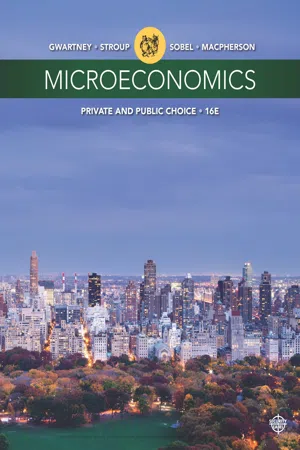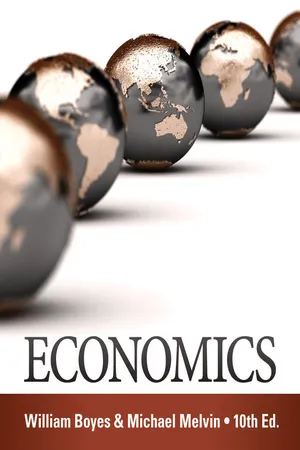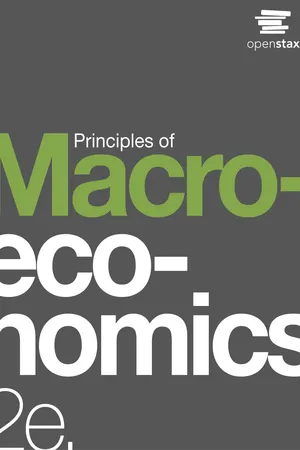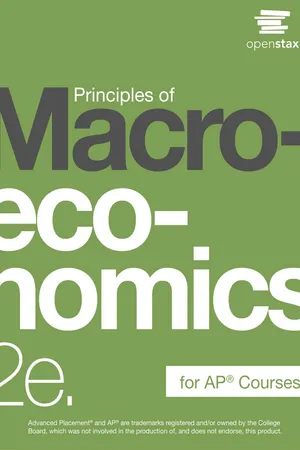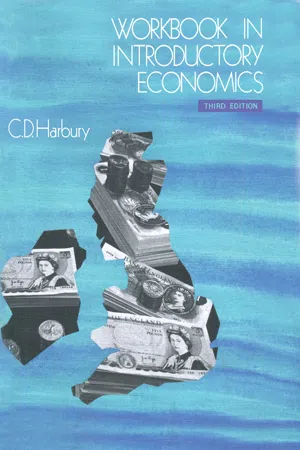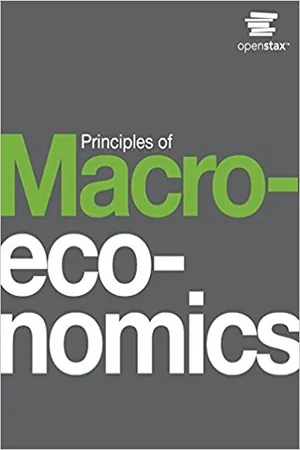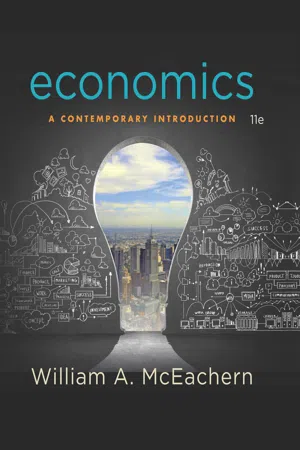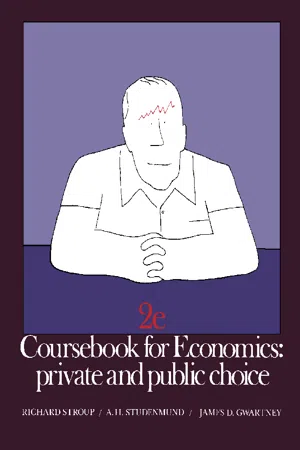Economics
The Demand for Resources
The demand for resources refers to the quantity of inputs, such as labor, capital, and natural resources, that firms and individuals are willing and able to purchase at various prices. It is influenced by factors such as the price of the resource, the prices of related goods, and technological advancements. Understanding resource demand is crucial for analyzing production and pricing decisions in an economy.
Written by Perlego with AI-assistance
Related key terms
1 of 5
11 Key excerpts on "The Demand for Resources"
- eBook - PDF
Microeconomics
Private and Public Choice
- James Gwartney, Richard Stroup, Russell Sobel, David Macpherson(Authors)
- 2017(Publication Date)
- Cengage Learning EMEA(Publisher)
All Rights Reserved. May not be copied, scanned, or duplicated, in whole or in part. WCN 02-300 250 PART 3 CORE MICROECONOMICS LOOKINGuni00A0AHEAD Productive assets and services are bought and sold in resource markets. There are two broad classes of productive resources: (1) nonhuman capital and (2) human capital. The Demand for Resources is derived from the demand for prod- ucts that the resources help produce. The quantity of a resource demanded is inversely related to its price because of substitu- tions made by both producers and consumers. The demand curve for a resource, like the demand for a prod- uct, can shift. The major factors that increase the demand for a resource are (1) an increase in demand for products that use the resource, (2) an increase in the productivity of the resource, and (3) an increase in the price of substitute resources. Profit-maximizing firms will hire additional units of a resource up to the point at which the marginal revenue product (MRP) of the resource equals its price. With multiple inputs, firms will expand their use of each until the marginal product divided by the price (MP/P) is equal across all inputs. When real-world decision makers minimize per-unit costs, the outcome will be as if they had followed these mathematical procedures, even though they may not consciously do so. • The amount of a resource supplied will be directly related to its price. The supply of a resource will be more elastic in the long run than in the short run. In the long run, investment can increase the supply of both physical and human resources. • The prices of resources are determined by supply and demand. Changes in the market prices of resources will influence the decisions of both users and suppliers. Higher resource prices give users a greater incentive to turn to substitutes and sup- pliers a greater incentive to provide more of the resource. - eBook - PDF
- William Boyes, Michael Melvin(Authors)
- 2015(Publication Date)
- Cengage Learning EMEA(Publisher)
The wage rate and the number of people employed are determined in the labor market. The cost of capital (the interest rate) and the quantity of capital used are determined in the capital market. Although each of these markets is somewhat unique, they are all markets, and thus they simply involve the demand for and supply of that particular resource. 29-1a The Resource Markets To understand the resource markets, you need to realize that the roles of firms and households are reversed from what they are in the product markets. Figure 1 illustrates the roles of firms and households in the product and resource markets. The market for goods and services is represented by the top lines in the figure. House-holds buy goods and services from firms, as shown by the line going from firms to households; and firms sell goods and services and receive revenue, as shown by the line going from households to firms. The resource market is represented by the bottom half of the diagram in Figure 1. Households are the sellers of resources, and firms are the buyers of resources. Households supply resources in order to earn income. By offering to work, individuals supply their labor; by saving, households supply firms with the funds used to purchase machines, equipment, and buildings; by offering their land and the minerals, trees, and other natural resources associated with it, households supply land. The supply of a resource con-sists of the sum of the quantities supplied by every resource owner. The supply of unskilled workers consists of the sum of the quantities that each and every unskilled worker is willing to work at each wage rate. The sup-ply of office space in Phoenix, Arizona, offered for rent consists of the supplies offered by every owner of office space in Phoenix. Resources are wanted not for themselves, but for what they produce. A firm uses resources in order to produce goods and services. - eBook - PDF
- Steven A. Greenlaw, Timothy Taylor, David Shapiro(Authors)
- 2017(Publication Date)
- Openstax(Publisher)
The likely reason is that people drive more in the summer, and are also willing to pay more for gas, but that does not explain how steeply gas prices fell. Other factors were at work during those six months, such as increases in supply and decreases in the demand for crude oil. This chapter introduces the economic model of demand and supply—one of the most powerful models in all of economics. The discussion here begins by examining how demand and supply determine the price and the quantity sold in markets for goods and services, and how changes in demand and supply lead to changes in prices and quantities. 3.1 | Demand, Supply, and Equilibrium in Markets for Goods and Services By the end of this section, you will be able to: • Explain demand, quantity demanded, and the law of demand • Identify a demand curve and a supply curve • Explain supply, quantity supplied, and the law of supply • Explain equilibrium, equilibrium price, and equilibrium quantity First let’s first focus on what economists mean by demand, what they mean by supply, and then how demand and supply interact in a market. 46 Chapter 3 | Demand and Supply This OpenStax book is available for free at http://cnx.org/content/col12190/1.4 Demand for Goods and Services Economists use the term demand to refer to the amount of some good or service consumers are willing and able to purchase at each price. Demand is fundamentally based on needs and wants—if you have no need or want for something, you won't buy it. While a consumer may be able to differentiate between a need and a want, but from an economist’s perspective they are the same thing. Demand is also based on ability to pay. If you cannot pay for it, you have no effective demand. By this definition, a homeless person probably has no effective demand for shelter. What a buyer pays for a unit of the specific good or service is called price. The total number of units that consumers would purchase at that price is called the quantity demanded. - Steven A. Greenlaw, Timothy Taylor, David Shapiro(Authors)
- 2017(Publication Date)
- Openstax(Publisher)
The likely reason is that people drive more in the summer, and are also willing to pay more for gas, but that does not explain how steeply gas prices fell. Other factors were at work during those six months, such as increases in supply and decreases in the demand for crude oil. This chapter introduces the economic model of demand and supply—one of the most powerful models in all of economics. The discussion here begins by examining how demand and supply determine the price and the quantity sold in markets for goods and services, and how changes in demand and supply lead to changes in prices and quantities. 3.1 | Demand, Supply, and Equilibrium in Markets for Goods and Services By the end of this section, you will be able to: • Explain demand, quantity demanded, and the law of demand • Identify a demand curve and a supply curve • Explain supply, quantity supplied, and the law of supply • Explain equilibrium, equilibrium price, and equilibrium quantity First let’s first focus on what economists mean by demand, what they mean by supply, and then how demand and supply interact in a market. 46 Chapter 3 | Demand and Supply This OpenStax book is available for free at http://cnx.org/content/col23729/1.3 Demand for Goods and Services Economists use the term demand to refer to the amount of some good or service consumers are willing and able to purchase at each price. Demand is fundamentally based on needs and wants—if you have no need or want for something, you won't buy it. While a consumer may be able to differentiate between a need and a want, but from an economist’s perspective they are the same thing. Demand is also based on ability to pay. If you cannot pay for it, you have no effective demand. By this definition, a homeless person probably has no effective demand for shelter. What a buyer pays for a unit of the specific good or service is called price. The total number of units that consumers would purchase at that price is called the quantity demanded.- eBook - PDF
- Steven A. Greenlaw, Timothy Taylor, David Shapiro(Authors)
- 2017(Publication Date)
- Openstax(Publisher)
The likely reason is that people drive more in the summer, and are also willing to pay more for gas, but that does not explain how steeply gas prices fell. Other factors were at work during those six months, such as increases in supply and decreases in the demand for crude oil. This chapter introduces the economic model of demand and supply—one of the most powerful models in all of economics. The discussion here begins by examining how demand and supply determine the price and the quantity sold in markets for goods and services, and how changes in demand and supply lead to changes in prices and quantities. 3.1 | Demand, Supply, and Equilibrium in Markets for Goods and Services By the end of this section, you will be able to: • Explain demand, quantity demanded, and the law of demand • Identify a demand curve and a supply curve • Explain supply, quantity supplied, and the law of supply • Explain equilibrium, equilibrium price, and equilibrium quantity First let’s first focus on what economists mean by demand, what they mean by supply, and then how demand and supply interact in a market. 46 Chapter 3 | Demand and Supply This OpenStax book is available for free at http://cnx.org/content/col12170/1.7 Demand for Goods and Services Economists use the term demand to refer to the amount of some good or service consumers are willing and able to purchase at each price. Demand is fundamentally based on needs and wants—if you have no need or want for something, you won't buy it. While a consumer may be able to differentiate between a need and a want, but from an economist’s perspective they are the same thing. Demand is also based on ability to pay. If you cannot pay for it, you have no effective demand. By this definition, a homeless person probably has no effective demand for shelter. What a buyer pays for a unit of the specific good or service is called price. The total number of units that consumers would purchase at that price is called the quantity demanded. - eBook - PDF
- Colin Harbury(Author)
- 2014(Publication Date)
- Pergamon(Publisher)
CHAPTER 2 Supply and Demand The work of this chapter is devoted to questions of resource allocation in the market for a single commodity. Resource allocation by the price mechanism is analysed with the use of the concepts of SUPPLY and DEMAND. In a market economy, resources are directed to the production of different goods by movements in their relative prices. If people want to purchase a good and price covers the cost of production, it is assumed that businesses will engage in its production in order to make a profit. If the price of a good is such that the amount which consumers wish to buy is not the same as the amount which suppliers are prepared to offer for sale, there will be some pressure on its price. If, on the other hand, price is such as to clear the market exactly with no disappointed consumers or producers, then the price and the market are said to be in EQUILIBRIUM. If price is above equilibrium there is excess supply of the good and producers will tend to compete with each other by lowering price. If the price is below equilibrium there is excess demand and some consumers will be prepared to pay more for the good, which will tend to push the price up. In such cases equilibrium is said to be stable, in that deviations from equilibrium set up economic forces which restore equilibrium. In some cases, e.g. when there are time lags between price and quantity changes, equilibrium may be unstable, when divergencies from equilibrium are not self-restoring. However, when a change occurs in the conditions of either supply or demand, such a reduction in costs or a shift in tastes, in so far as it exerts pressure on the price of a good, it will normally set up market forces leading towards a new equilibrium. The forces of supply and demand working through the price mechanism can be thought of as helping to solve the central economic problems of any society. Prices act, as it were, as signals which perform two functions. - eBook - PDF
- Steven A. Greenlaw, Timothy Taylor(Authors)
- 2014(Publication Date)
- Openstax(Publisher)
The likely reason is that people drive more in the summer, and are also willing to pay more for gas, but that does not explain how steeply gas prices fell. Other factors were at work during those six months, such as increases in supply and decreases in the demand for crude oil. This chapter introduces the economic model of demand and supply—one of the most powerful models in all of economics. The discussion here begins by examining how demand and supply determine the price and the quantity sold in markets for goods and services, and how changes in demand and supply lead to changes in prices and quantities. 3.1 | Demand, Supply, and Equilibrium in Markets for Goods and Services By the end of this section, you will be able to: • Explain demand, quantity demanded, and the law of demand • Identify a demand curve and a supply curve • Explain supply, quantity supply, and the law of supply • Explain equilibrium, equilibrium price, and equilibrium quantity First let’s first focus on what economists mean by demand, what they mean by supply, and then how demand and supply interact in a market. 44 Chapter 3 | Demand and Supply This OpenStax book is available for free at http://cnx.org/content/col11626/1.10 Demand for Goods and Services Economists use the term demand to refer to the amount of some good or service consumers are willing and able to purchase at each price. Demand is based on needs and wants—a consumer may be able to differentiate between a need and a want, but from an economist’s perspective they are the same thing. Demand is also based on ability to pay. If you cannot pay for it, you have no effective demand. What a buyer pays for a unit of the specific good or service is called price. The total number of units purchased at that price is called the quantity demanded. A rise in price of a good or service almost always decreases the quantity demanded of that good or service. Conversely, a fall in price will increase the quantity demanded. - eBook - PDF
Microeconomics
A Contemporary Introduction
- William A. McEachern(Author)
- 2016(Publication Date)
- Cengage Learning EMEA(Publisher)
Resource demand curves slope downward because firms are more willing and able to increase quantity demanded as the resource price declines. Resource supply curves slope upward because resource owners are more willing and able to increase quantity supplied as their rewards for doing so increase. 3. Some differences in the market prices of similar resources trig-ger the reallocation of resources to equalize those prices. Other price differences do not cause a shift of resources among uses because of a lack of resource mobility, differences in the inher-ent quality of the resources, differences in the time and money involved in developing necessary skills, and differences in non-monetary aspects of jobs. 4. Resource earnings divide between (a) opportunity cost and (b) economic rent—that portion of earnings that exceeds oppor-tunity cost. If a resource has no other use beyond the market in question, earnings consist entirely of economic rent. If a resource has other uses that pay just as well, earnings consist entirely of opportunity cost. Most resources earn both econom-ic rent and opportunity cost. 5. A firm’s demand curve for a resource is the resource’s mar-ginal revenue product curve, which shows the change in to-tal revenue from employing one more unit of the resource, other things constant. If a firm sells output in a competitive market, the marginal revenue product curve slopes down-ward because of diminishing marginal returns only. If a firm has some power in the product market, the marginal revenue product curve slopes downward both because of diminishing marginal returns and because the price of the output must fall to sell more. 6. The demand curve for a resource shifts to the right if (a) its marginal productivity increases, (b) the output price increases, (c) the price of a substitute resource increases, or (d) the price of a complement resource decreases. - eBook - PDF
Economics
A Contemporary Introduction
- William A. McEachern(Author)
- 2016(Publication Date)
- Cengage Learning EMEA(Publisher)
Resource demand curves slope downward because firms are more willing and able to increase quantity demanded as the resource price declines. Resource supply curves slope upward because resource owners are more willing and able to increase quantity supplied as their rewards for doing so increase. 3. Some differences in the market prices of similar resources trig- ger the reallocation of resources to equalize those prices. Other price differences do not cause a shift of resources among uses because of a lack of resource mobility, differences in the inher- ent quality of the resources, differences in the time and money involved in developing necessary skills, and differences in non- monetary aspects of jobs. 4. Resource earnings divide between (a) opportunity cost and (b) economic rent—that portion of earnings that exceeds oppor- tunity cost. If a resource has no other use beyond the market in question, earnings consist entirely of economic rent. If a resource has other uses that pay just as well, earnings consist entirely of opportunity cost. Most resources earn both econom- ic rent and opportunity cost. 5. A firm’s demand curve for a resource is the resource’s mar- ginal revenue product curve, which shows the change in to- tal revenue from employing one more unit of the resource, other things constant. If a firm sells output in a competitive market, the marginal revenue product curve slopes down- ward because of diminishing marginal returns only. If a firm has some power in the product market, the marginal revenue product curve slopes downward both because of diminishing marginal returns and because the price of the output must fall to sell more. 6. The demand curve for a resource shifts to the right if (a) its marginal productivity increases, (b) the output price increases, (c) the price of a substitute resource increases, or (d) the price of a complement resource decreases. - eBook - PDF
Coursebook for Economics
Private and Public Choice
- Richard Stroup, A. H. Studenmund, James D Gwartney(Authors)
- 2014(Publication Date)
- Academic Press(Publisher)
Why are individuals willing to supply resources? Do they seek to maximize their income? Do they seek to gain the highest possible rate of return on their ownership of resources? Does 274 23/THE SUPPLY AND DEMAND OF PRODUCTIVE RESOURCES the rate of return to resource suppliers influence their invest-ment decisions? Explain. 5. Suppose that the annual real earnings of aero-space en-gineers increases by 15 percent because of a sharp expansion in the demand for their services. Do you think that the num-ber of aero-space engineers will increase very much after six months? After two years? After five years? Explain. 6. What impact would each of the following have on the de-mand for economists? a. an increase in government research funds for the study of wage-price controls b. increased reliance on student tuition as a method of financing education c. the establishment of a planning agency that must analyze and decide whether labor-management contracts are inflationary d. reduced emphasis on government planning and an in-creased reliance on the market mechanism 24 EARNINGS, SKILL ACQUISITION, AND THE JOB MARKET TRUE OR FALSE T F 1. Immobility of labor is a major source of wage differ-entials. T F 2. Higher productivity generally leads to higher wages. T F 3. Investment in physical capital is a larger share of GNP in the United States than in most other nations. T F 4. Owners of physical capital in the United States re-ceive about 40 percent of national income. T F 5. Automation always reduces production costs and employment within a firm. T F 6. Automation almost always reduces the demand for labor in the economy. T F 7. Despite the importance that some place on jobs, an expansion in production per worker is the primary source of high living standards. T F 8. Minimum-wage legislation helps low-wage workers, particularly teenagers, whereas the burden of the legislation is imposed almost exclusively on high-wage workers. - eBook - PDF
- James D Gwartney, Richard Stroup, J. R. Clark(Authors)
- 2014(Publication Date)
- Academic Press(Publisher)
Buyers can now be more selective, since sellers want to sell more than buyers, in aggregate, desire to purchase. Buyers can be expected to seek out sellers willing to offer them favors (discounts on other products, easier credit, or better service, for example). Some sellers may be unable to market their product or service. 8 Unsold merchandise and underutilized resources will result. Note that a surplus does not mean the good is no longer scarce. People still want more of the good than is freely available from Nature, even though they desire less, at the current price, than sellers desire to bring to the market. A decline in price would eliminate the surplus but not the scarcity of the item. HOW THE MARKET ANSWERS THE THREE BASIC ECONOMIC QUESTIONS How does the market's pricing mechanism resolve the three basic economic questions— what goods will be produced, how will they be produced, and for whom will they be produced? In a market economy, what will be produced is determined by the con-sumer's evaluation of a good (demand) relative to its opportunity cost (supply). If consumers value a good (in terms of money) more than its opportunity cost, they will choose to purchase it. Simultaneously, profit-seeking producers will 8 Our theory indicates that minimum wage legislation (a price floor for unskilled labor) will generate an excess supply of inexperienced, low-skilled workers. The extremely high unemployment rate of teenagers—a group with little work experience—supports this view. CHAPTER 3 SUPPLY, DEMAND, AND THE MARKET PROCESS 5 3 supply a good as long as consumers are willing to pay a price that is sufficient to cover the opportunity cost of producing the good. The result: There is an in-centive to produce those goods, and only those goods, to which consumers attach a value at least as high as the production costs of the goods. How goods will be produced is determined by the economizing behavior of suppliers.
Index pages curate the most relevant extracts from our library of academic textbooks. They’ve been created using an in-house natural language model (NLM), each adding context and meaning to key research topics.
